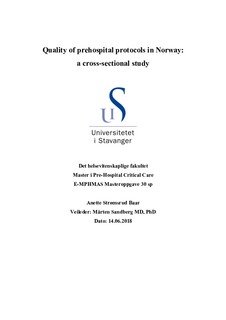| dc.contributor.advisor | Sandberg, Mårten | |
| dc.contributor.author | Baar, Anette Strømsrud | |
| dc.coverage.spatial | Norway | nb_NO |
| dc.date.accessioned | 2018-11-01T07:52:28Z | |
| dc.date.available | 2018-11-01T07:52:28Z | |
| dc.date.issued | 2018-06-14 | |
| dc.identifier.uri | http://hdl.handle.net/11250/2570490 | |
| dc.description | Master's thesis in Pre-hospital critical care | nb_NO |
| dc.description.abstract | ABSTRACT
Background
Medical protocols are intended to support health care providers and ensure quality in potential difficult decision making regarding assessment and treatment of patients. The aim of this study was to determine the quality of the process resulting in medical protocols regulating the prehospital assessment and patient treatment in the emergency medicine service (EMS) system in Norway.
Methods
This was a quantitative cross-sectional study of 47 medical protocols used to treat anaphylaxis, sepsis and acute ischemic stroke. The included protocols were assessed by a modified Appraisal of Guidelines for Research and Evaluation 2 (AGREE2) assessment tool, with a possible score range between 20 and 140.
Results
Seventeen of the 18 ambulance services in Norway participated in this study. Three EMS had medical manuals with open access online. Six of the 17 EMS systems collaborate and use the same manuals, resulting in a total of 12 different manuals. All 12 manuals included protocols for assessment and treatment of anaphylaxis, two EMSs did not have sepsis protocols and one EMS did not have a protocol for treatment of patients with suspected acute ischemic stroke. The assessment of the protocols using AGREE2 assessment tool was carried out by evaluating the written documentation handed out by each EMS system. The assessment results varied from 26 to 121 with a median of 61.
Discussion
The assessment and treatment in all 17 EMSs are based on 12 manuals with a large variation in quality and the average quality of the assessed protocols was low. More research is needed especially regarding adherence to protocols in practice. It seems like collaboration has a positive effect on quality and national medical protocols should therefore be considered. | nb_NO |
| dc.language.iso | eng | nb_NO |
| dc.publisher | University of Stavanger, Norway | nb_NO |
| dc.relation.ispartofseries | Masteroppgave/UIS-HV/2018; | |
| dc.rights | Navngivelse 4.0 Internasjonal | * |
| dc.rights.uri | http://creativecommons.org/licenses/by/4.0/deed.no | * |
| dc.subject | helse- og sosialfag | nb_NO |
| dc.subject | phcc | nb_NO |
| dc.subject | prehospital | nb_NO |
| dc.subject | emergency medicine | nb_NO |
| dc.subject | medical protocols | nb_NO |
| dc.subject | protocols | nb_NO |
| dc.subject | quality | nb_NO |
| dc.subject | akuttmedisin | nb_NO |
| dc.subject | prehospitale tjenester | nb_NO |
| dc.title | Quality of prehospital protocols in Norway: a cross-sectional study | nb_NO |
| dc.type | Master thesis | nb_NO |
| dc.subject.nsi | VDP::Medisinske Fag: 700::Klinisk medisinske fag: 750 | nb_NO |

